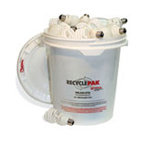It is just as important to recycle your old incandescent and fluorescent lamps as it is to purchase new, energy efficient and environmentally safe LEDs. Millions of light bulbs end up in landfills every year, and the toxins from the lamps contaminate the soil and other surrounding garbage at the dumps. If people continue to toss lamps in the garbage, we will run the risk of having our drinking water and soil contaminated from toxins and glass. Recycling light bulbs will help prevent the release of mercury into the landfills. Lamps aren’t built very durable and can easily break during transport to landfills, if not in them. Some parts of light bulbs can also be recycled, such as the glass and metals used to build the lamps. Also, some states require that citizens recycle lamps that contain mercury. California, New Hampshire, Vermont, and Minnesota are some of the states that have these laws.
 So where should you recycle your light bulbs? Inquire within your community to see if there are recycling centers. If you visit www.earth911.com, you can enter what you want to recycle and where you are located, and the website generates locations of specific recycling centers. You can also contact your local hardware stores, which should have a light bulb recycling program. Many Home Depots, Ace Hardware stores, IKEAs, and Lowes have in-store recycling. Certain companies, such as Osram Sylvania, have mail-in recycling programs. You buy a bag or a box, you fill it with bulbs, and the company covers the cost of shipping the bulbs back! If there is absolutely no way you can recycle, at least put your light bulb in a sealed plastic bag before you toss it in the garbage. If it breaks, the mercury will be contained in the bag.
So where should you recycle your light bulbs? Inquire within your community to see if there are recycling centers. If you visit www.earth911.com, you can enter what you want to recycle and where you are located, and the website generates locations of specific recycling centers. You can also contact your local hardware stores, which should have a light bulb recycling program. Many Home Depots, Ace Hardware stores, IKEAs, and Lowes have in-store recycling. Certain companies, such as Osram Sylvania, have mail-in recycling programs. You buy a bag or a box, you fill it with bulbs, and the company covers the cost of shipping the bulbs back! If there is absolutely no way you can recycle, at least put your light bulb in a sealed plastic bag before you toss it in the garbage. If it breaks, the mercury will be contained in the bag.
